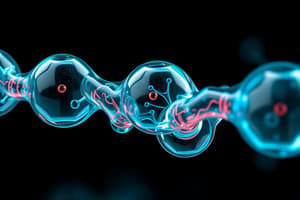Podcast
Questions and Answers
What do oxidoreductases catalyze?
What do oxidoreductases catalyze?
- Transfer of functional groups
- Joining two large biomolecules
- Cleavage with the addition of water
- Oxidation-reduction reactions (correct)
What is the primary function of transferases?
What is the primary function of transferases?
Move a functional group from one molecule to another.
What do hydrolases catalyze?
What do hydrolases catalyze?
Cleavage with the addition of water.
What is a distinguishing feature of lyases?
What is a distinguishing feature of lyases?
What do isomerases do?
What do isomerases do?
What are ligases responsible for?
What are ligases responsible for?
What are constitutional isomers?
What are constitutional isomers?
What are stereoisomers?
What are stereoisomers?
The classes of enzymes can be remembered by the acronym ______.
The classes of enzymes can be remembered by the acronym ______.
List the classes of enzymes represented by the acronym 'LIL HOT'.
List the classes of enzymes represented by the acronym 'LIL HOT'.
Flashcards are hidden until you start studying
Study Notes
Enzyme Classes Overview
-
Oxidoreductases: Catalyze oxidation-reduction reactions; involve the transfer of electrons where at least one substrate gets oxidized and one reduced.
-
Transferases: Enzymes that facilitate the transfer of functional groups from one molecule to another, playing a critical role in various metabolic reactions.
-
Hydrolases: Catalyze the cleavage of bonds through the addition of water; break C-O, C-N, and C-S bonds in hydrolysis reactions by adding OH and H+ ions.
-
Lyases: Enzymes that cleave substrates without adding water and do not transfer electrons; they are often involved in the reverse reaction which is more biologically significant.
-
Isomerases: Enzymes that catalyze the interconversion of isomers—both constitutional and stereoisomers; they rearrange atoms within molecules to produce isomers.
-
Ligases: Responsible for joining large biomolecules, typically through the synthesis of various bonds (C-C, C-S, C-O, C-N) by utilizing the energy derived from ATP cleavage.
Isomer Types
-
Constitutional Isomers: Molecules that share the same molecular formula but differ in the bonding order of atoms, resulting in distinct compounds.
-
Stereoisomers: Molecules with the same molecular formula and connectivity as their constitutional isomers but vary in the spatial orientation of their bonds, leading to different properties.
Quick Reference for Enzyme Classes
- LIL HOT: An acronym for remembering the classes of enzymes:
- L - Ligases
- I - Isomerases
- L - Lyases
- H - Hydrolases
- O - Oxidoreductases
- T - Transferases
Studying That Suits You
Use AI to generate personalized quizzes and flashcards to suit your learning preferences.




